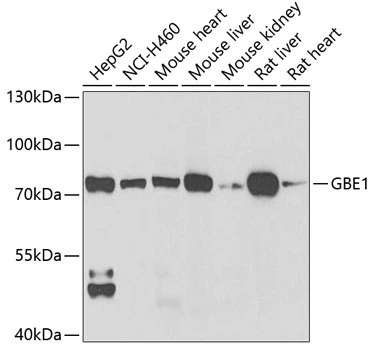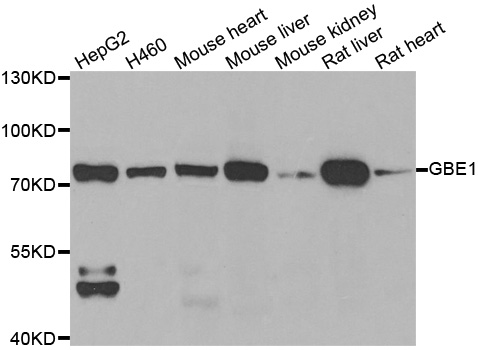
WB analysis of various sample lysates using GTX32621 GBE1 antibody. Dilution : 1:1000 Loading : 25microg per lane
GBE1 antibody
GTX32621
ApplicationsWestern Blot
Product group Antibodies
ReactivityHuman, Mouse, Rat
TargetGBE1
Overview
- SupplierGeneTex
- Product NameGBE1 antibody
- Delivery Days Customer9
- Application Supplier NoteWB: 1:500 - 1:2000. *Optimal dilutions/concentrations should be determined by the researcher.Not tested in other applications.
- ApplicationsWestern Blot
- CertificationResearch Use Only
- ClonalityPolyclonal
- ConjugateUnconjugated
- Gene ID2632
- Target nameGBE1
- Target description1,4-alpha-glucan branching enzyme 1
- Target synonymsAPBD, GBE, GSD4, 1,4-alpha-glucan-branching enzyme, amylo-(1,4 to 1,6) transglucosidase, amylo-(1,4 to 1,6) transglycosylase, brancher enzyme, glucan (1,4-alpha-), branching enzyme 1, glycogen branching enzyme
- HostRabbit
- IsotypeIgG
- Protein IDQ04446
- Protein Name1,4-alpha-glucan-branching enzyme
- Scientific DescriptionThe protein encoded by this gene is a glycogen branching enzyme that catalyzes the transfer of alpha-1,4-linked glucosyl units from the outer end of a glycogen chain to an alpha-1,6 position on the same or a neighboring glycogen chain. Branching of the chains is essential to increase the solubility of the glycogen molecule and, consequently, in reducing the osmotic pressure within cells. Highest level of this enzyme are found in liver and muscle. Mutations in this gene are associated with glycogen storage disease IV (also known as Andersens disease). [provided by RefSeq, Jul 2008]
- ReactivityHuman, Mouse, Rat
- Storage Instruction-20°C or -80°C,2°C to 8°C
- UNSPSC12352203



![ICC/IF analysis of COS7 cells transiently transfected with GBE1 plasmid using GTX84452 GBE1 antibody [1D11].](https://www.genetex.com/upload/website/prouct_img/normal/GTX84452/GTX84452_1084_ICCIF_w_23061420_749.webp)
![ICC/IF analysis of COS7 cells transiently transfected with GBE1 plasmid using GTX84453 GBE1 antibody [4D9].](https://www.genetex.com/upload/website/prouct_img/normal/GTX84453/GTX84453_1086_ICCIF_w_23061420_628.webp)
![IHC-P analysis of human ovary adenocarcinoma tissue using GTX84454 GBE1 antibody [3C8]. Antigen retrieval : Heat-induced epitope retrieval by 10mM citrate buffer, pH6.0, 100oC for 10min.](https://www.genetex.com/upload/website/prouct_img/normal/GTX84454/GTX84454_2739_IHC-P_w_23061420_516.webp)
![IHC-P analysis of human liver carcinoma tissue using GTX84456 GBE1 antibody [3B4]. Antigen retrieval : Heat-induced epitope retrieval by 10mM citrate buffer, pH6.0, 100oC for 10min.](https://www.genetex.com/upload/website/prouct_img/normal/GTX84456/GTX84456_2741_IHC-P_w_23061420_127.webp)
